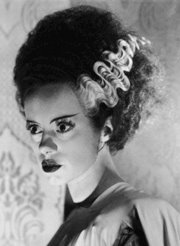The actress Elsa Lanchester's mother was kidnapped, in her early 20's, in late 19th c. London, from the home she shared with her lover, Lanchester's father, because they hadn't been married, and were consequently living in sin. By her own father and her own brother. 
She was taken to a private asylum and held there for more than a day or two, though less than a month. The idea being she was insane, because she was living with Lanchester's father out of wedlock. This idea was corroborated by medical professionals.
They never did get married, though producing Lanchester and her older brother, and living together into their elder years.
Lanchester's most famous role by far was as the eponymous "Bride of Frankenstein".
In the uncut original she plays Mary Shelley on that dark and stormy night with Byron and Percy, as the tale begins.
She was married to Charles Laughton, whose career and fame far overshadowed hers.
Laughton was a relatively discreet homosexual. Their's was an unusual but loving and long relationship.
Laughton's family was Catholic and there was some conflict, as Lanchester records it, at the time of his death about his antipathy toward Catholicism.
The Wikipedia entry for Lanchester seems to have been written by someone still engaged in that conflict.
She was a founder of the Turnabout Theater in LA. (link to LA Pub. Lib. images)
Photographs of her in her autobiography, "Elsa Lanchester, Herself" make it seem likely she was an alcoholic.
As a young woman, before she married Laughton, Lanchester dined with, on separate occasions, Aleister Crowley the famous Satanist and covert operative, and Theo. Herzl, the public founder of present-day Zionism.
The social morality that made it possible, if not imperative, that Lanchester's grandfather "rescue" her mother by force, against her will, from the awful sin of unsanctioned cohabitation, has altered itself.
But there was never a moment of admission of fault, never any shame - just slow change, an evolution toward more enlightened morality, undirected, uncodified, in stark contrast at its extremes, but unnoticeable in the midst of its progression.
This leaves open the possibilty that there are still pathologies in the public moral code.







